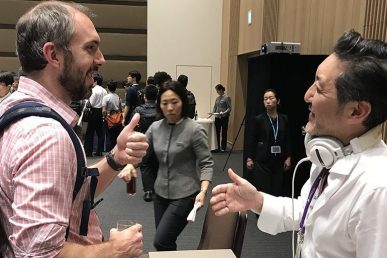AUSTIN, Texas — The numbers say it all: with 50 billion devices connected and 400 million servers by 2020, infrastructure must change with the times.
That’s the main message from Mark Collier, OpenStack Foundation COO on the second day of the Summit. To manage that much infrastructure, new tools and patterns will be required which can handle bare metal, virtual machines, and containers. The opportunity is massive, but it will require collaboration across many open source communities, keeping in mind what users want and need, because it’s collaborate or die in the billion device, billion core era.
"We can’t do it alone," Collier said. He named some of the "big dogs" of the industry that use OpenStack — AT&T, Walmart, State Grid, China Mobile and VW — underscoring his point that to survive and thrive they need to be part of open community.
"There’s no such thing as too big to fail in technology," Collier said. OpenStack will be the integration engine for users embracing new technologies, since, much like the Republican primary, there’s no clear favorite yet.
The latest #OpenStack user survey identified containers, NFV / SDN & bare metal as the top emerging technologies pic.twitter.com/dXNg73A7MQ
— OpenStack (@OpenStack) April 26, 2016
What’s next? Collier is the first to admit he doesn’t know. He envisions there will be a LAMP stack for OpenStack but says the community should remove its blinders. "Whatever our LAMP stack is it will be OpenStack and__. I’m counting on you to help me fill in the blanks."
His message was echoed by Cisco’s CTO extraordinaire Lew Tucker, whose talk started by taking a few giant steps backward for mankind noting that homo sapiens are the only animals who can cooperate at such high levels.
"Above all man is an inventor. We’re not content to accept what nature has provided us," he said. Human collaboration is helping us re-imagine the world, and at Cisco a good chunk of that is working with open communities. The historic Silicon Valley firm has been deeply involved with OpenStack since 2011 and Tucker outlined their work with communities such as Open Daylight and other software-defined networking projects.
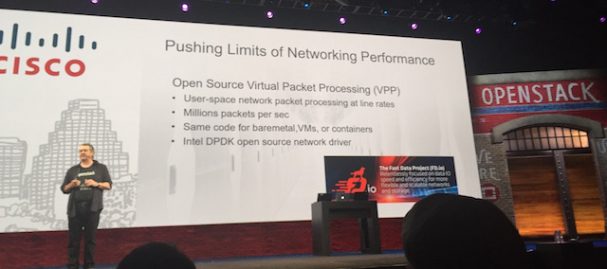
Tucker finished on a high note – reminding participants not to take themselves "too seriously" and hinting at the return of cloud rapping duo Dope’n’Stack.
I like @lewtucker’s focus on abstraction as a leading force for change, both in software and in software communities. #OpenStackSummit
— Scott S. Lowe (@scott_lowe) April 26, 2016
Brave new world
Two OpenStack users took the stage — both of them called "brave" by Collier. Both are pushing the frontiers of working with OpenStack and containers.
First up was LivePerson’s Koby Holzer. The company started with OpenStack way back in the Diablo release.
"We’ve come a long ways since then," Holzer said, adding that they are currently upgrading to Kilo and have a mind-warping 8,000 instances on 20,000 cores running in seven data centers worldwide. The current set-up has Kubernetes and Docker managing 150 microservices, deployed in VMs. What’s next for LivePerson’s OpenStack environment? Full-scale Kubernetes and expanding into public clouds."It’s been a long and brave journey, and OpenStack enabled it."
It takes a different kind of brave to challenge the live demo gods, but Alex Polvi CoreOS CEO was up for it.
"I need you all to free your mind, OpenStack is an application," Polvi said. He teamed up with Google’s Craig McLuckie to show fully containerized OpenStack running on top of Kubernetes. The powers-that-be were on their side – and he successfully demoed self-healing and rolling upgrades. You can find out more about the Tectonic project here and check out the full demo below.
https://twitter.com/rgbkrk/status/724974014993584128
We are OpenStack
It’s always good to see different sides of the OpenStack community take center stage. The L.I.K.A. team came all the way from Taiwan to showcase the app they made over a weekend at the first OpenStack Hackathon.
There were 38 teams competing for a grand prize trip to the Austin Summit, and over 200 people participated, their backgrounds ranging from private companies, government, universities and research institutions. The winning app uses OpenStack Sahara for big data and measures muscle movement for musicians–which the team showcased onstage with a live guitar player.
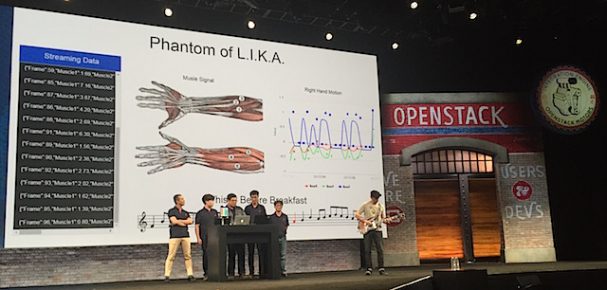
The L.I.K.A. team demos in Austin.
Collier announced the next Hackathon, slated for September in Mexico. Here’s more on how your local user group could be next.
Smart Cities
The community gathered in a different way for the tcp cloud demo. The company is at work on a smart city project in Pisek, about about 60 miles south of Prague — a project that employs OpenStack, Kubernetes, Hadoop and OpenContrail. But Jakub Pavlik, CTO, gave an example of the project that hit closer to home, using sensors at the Austin Convention Center to measure CO2 output. "You can tell when the keynotes ended, and when everyone went to lunch," Pavlik said over waves of applause from the 7,500 attendees. "It’s a geek thing, I know." The API is public and available at https://austin.tcpcloud.eu/
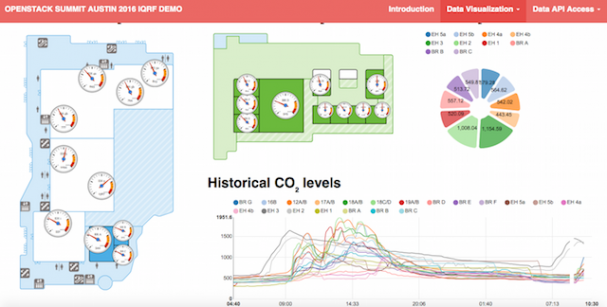
Breathe deeply: CO2 at the Austin Summit.
"The Internet of things isn’t just a buzzword, it’s not just tech pr or vendor solutions," Pavlik said. "It’s about the power of the community and taking different pieces of open source and making it work."
OK, @tcpcloud wins the live demo award at #openstack summit pic.twitter.com/nWamzmYzWk
— Thierry Carrez @[email protected] (@tcarrez) April 26, 2016
You can also read more about the smart city project in the print edition of Superuser magazine, available at the Summit.
Smarter scientists
In a talk called "Underhyped but Changing the World: OpenStack for Universities and Research" Dan Stanzione, the executive director of Texas Advanced Computing Center (TACC) dropped the knowledge on two large-scale projects, Chameleon and Jet Stream, using OpenStack.
Chameleon is an experimental test bed for cloud architecture and applications that, much like its namesake, adapts to user needs. There are currently 700 users working on about 150 projects, ranging from classifying cybersecurity attacks to crunching data from the Large Hadron Collider (LHC.)
Jetstream just rolled out to early users. It’s billed as the first user-friendly, scalable cloud environment for Extreme Science and Engineering Discovery Environment (XSEDE), a single virtual system where scientists interactively share computing resources, data and expertise. Stanzione said that users are at work on projects that span from psychology to an app that can tell you which kind of snake just bit you. (Collier’s spoiler alert – if you’re in Texas, it’s a rattlesnake.)
There’s more about TACC in the print edition of Superuser magazine, available at the Summit.
What’s moving the public cloud momentum
Capping the morning’s user sessions, OVH’s Maxime Hurtrel
spoke of his company’s "love story" with OpenStack. Launched in 1999 in an attic, the Internet service provider offers dedicated servers, shared and cloud hosting, domain registration and voice over IP services. The romance started in 2012 with Swift and has grown deeper with each passing year to arrive at 75 petabytes on Swift, 70,000 instances and 430,000 production servers in March 2016.
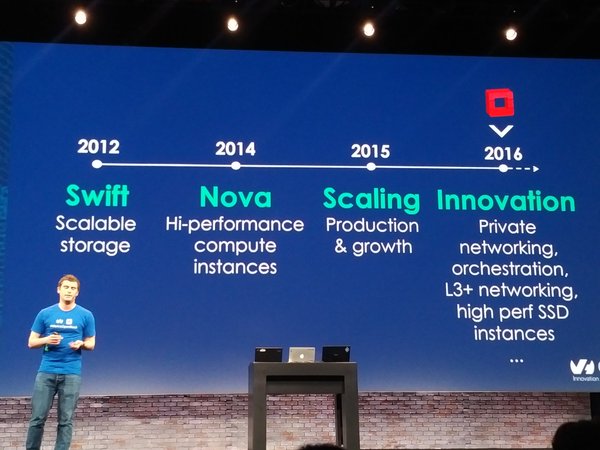
Stay tuned for more from the Summit!
- Demystifying Confidential Containers with a Live Kata Containers Demo - July 13, 2023
- OpenInfra Summit Vancouver Recap: 50 things You Need to Know - June 16, 2023
- Congratulations to the 2023 Superuser Awards Winner: Bloomberg - June 13, 2023

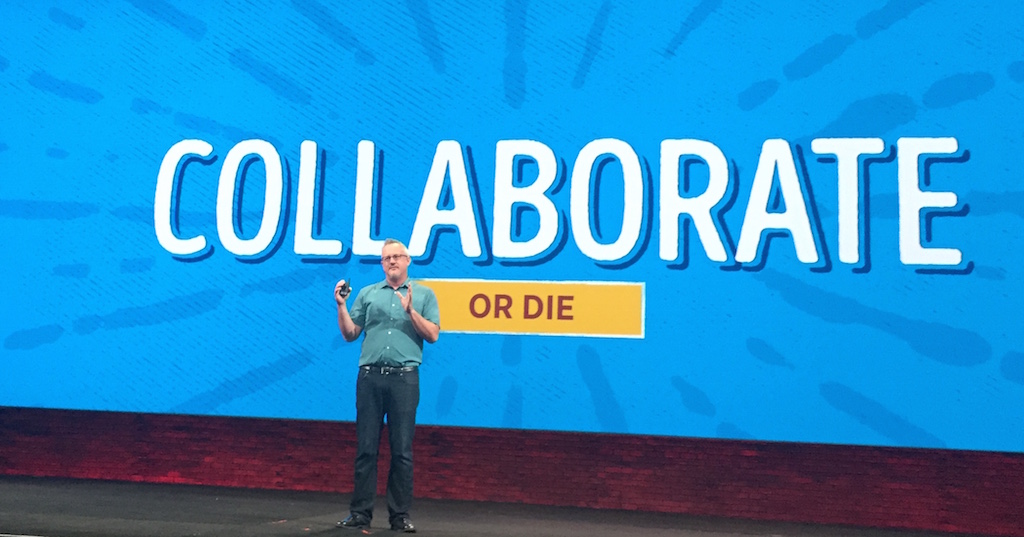)






